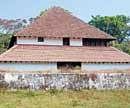

Though the tiny, but picturesque district of Kodagu is often hailed as the land of warriors and kings, when it comes to forts and palaces built by erstwhile rulers, the monuments seem to be few.
The one palace that stands out amidst lofty mountains and verdant forests is the Nalknad Palace. Close to the village of Kakkabe near Virajpet, a little deviation from the main road leads to this rather secluded monument which is visited more by passing trekkers heading to climb the Tadiandamol Peak than regular tourists. Its architectural attractions as well as its intriguing history are often missed out.
And a palace came into view...
At a bend on the way up from Kakkabe, an indication to the left guided me to an open grass field where from amidst the tall trees and shrubs the palace came into view abruptly. It is a very wide two-storeyed structure with white walls and tiled roofs. The main entrance with tall, well-carved wooden doors leads to a sprawling courtyard with the paths lined by flowering plants. As Anand, the caretaker here offered to take me around more facts come to the fore. The small enclosure at the immediate right of the pathway is the Kalyanamantapa, a brick and mortar structure with sculpted decorative figures on its top corners. We walked ahead to the steps leading to the main hall but not before appreciating the finely carved pair of elephants flanking the steps.
The rooms at the extreme left were once the kitchen and an armoury. The stairs took us to the wide and spacious upper floor. As we entered the king’s room on the left, Anand drew my attention to the ceiling designs. The uniform box-like depressions with brown red flowery ornamentations suggested the king was a connoisseur of art. He was none other than the valiant Doddaveerarajendra who was instrumental in winning back the kingdom from the clutches of Tipu.
A bone of contention
After the fall of the Vijayanagar empire, a line of Wodeyars successively ruled the hilly terrain of Kodagu. The Mysore rulers Hyder Ali and later his son Tipu had always nurtured a plan to conquer Kodagu.
During one such attempt in the 1780s, Tipu took the young Prince, Doddaveerarajendra as a prisoner and detained him in Piriyapatna. But the Kodagu soldiers revolted and assisted him to flee from prison and establish his rule at a place called Kurichi. However, his territorial disputes with the Kote Raja of Kerala made the latter burn this palace and kill his family members. At this juncture, Doddaveerarajendra who only had the support of his people, had no option but to seek the help of the British fighting Tipu so that the latter could be kept at bay.
Built in 1792
While the Anglo-Mysore wars engaged Tipu, the king Dodaveerarajendra developed his territory, ensured a good administration and also built this palace at Nalknad in 1792.
His soldiers too developed their expertise in guerrilla warfare suited to the hills and thwarted many an attempt to conquer Kodagu. King Doddaveerarajendra once again established his rule in Kodagu.
Later with the intention of begetting a heir to his throne he married Mahadevammaji in 1796 at the very Kalyanamantapa mentioned earlier. When she too could not bear a son for him, his brother Lingarajendra and after him Chikkaveerarajendra held the rule before being taken over by the British.
Impressive mural
Coming back to the present, we admired the series of hexagonal wooden pillars supporting the roof before moving into the queen’s room with an exclusive bath. Here too the ceiling decorated with age old painting still intact caught the eye. We saw four dark rooms at the backyard meant for confining prisoners. At the main hall on the ground floor, the huge mural on the wall is impressive. Named Royal Procession, the painting depicts the king riding his elephant, surrounded by soldiers and musicians.
The original paintings are fading under coats of lime wash rendered on them over the years. But the efforts of INTACH ( The Indian National Trust for Art & Cultural Heritage) in restoring the paintings by treating the limewash chemically is certainly laudable. Also the palace which till recently was used a bee-keeping centre is now being maintained neatly by the archaeological department.
Getting there
Kakkabe, the nearest town is connected with other towns by buses that pass through Virajpet (about 245 kms from Bangalore ). Homestays and hotels nearby offer food and accommodation.)